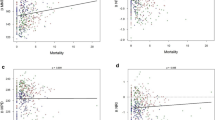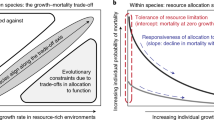Abstract
The species diversity of trees maintained in tropical rain forests is much higher than in temperate, boreal, or seasonally dry tropical forests. Many hypotheses have been proposed for higher diversity in tropical rain forests, including: (i) higher specialization of resource use, (ii) different mode of disturbance, (iii) smaller opportunity for competition on oligotrophic soil, (iv) higher productivity, (v) more active specific herbivores and pathogens, (vi) evolutionary/ecological history. In this paper we report mathematical models for tree-by-tree replacement. First the analysis of random drift model shows that the effect of gap size to species diversity is not very strong. Second we study phenological segregation model, which has the following assumptions: Basic mechanism for many species to coexist in the community is assumed given by the storage effect of lottery model, as species differ in seasonality in peak fruit production and in the subsequent period of high regeneration ability. Gaps formed during unfavorable season accumulate and become available for regeneration in the beginning of the growing season. The resulting synchronization of regeneration opportunity jeopardizes the coexistence of many similar species in seasonal environments. Analysis of a mathematical model shows: (1) the existence of unfavorable season can greatly reduce the diversity of coexisting species. (2) Diversity in the equilibrium community can be high when niche width of each species is broad and resource use is strongly overlapped. (3) Equilibrium community may include several distinct groups of species differing in phenology of regeneration. Effect of unequal niche width and frequency dependent regeneration are also examined.
Similar content being viewed by others
References
Adams, J.M. & Woodward, F.I. 1989. Patterns in tree species richness as a test of the glacial extinction hypothesis. Nature 339: 699–701.
Ashton, P.S. 1977. A contribution of rainforest research to evolutionary theory. Annals of the Missouri Botanical Garden 64: 694–705.
Augspurger, C.K. 1983. Offspring recruitment around tropical trees: changes in cohort distance with times. Oikos 40: 189–196.
Begon, M., Harper, J.L. & Townsend, C.R. 1990. Ecology: individuals, populations and communities. Blackwell Scientific Publications, London, England.
Bremermann, H.J. & Fiedler, B. 1985. On the stability of polymorphic host-pathogen populations. Journal of theoretical Biology 117: 621–631.
Chesson, P.L. & Warner, R.R. 1981. Environmental variability promotes coexistence in lottery competitive systems. American Naturalist 117: 923–943.
Clark, D.A. & Clark, D.B. 1984. Spacing dynamics of a tropical rain forest tree: evaluation of the Janzen-Connell model. American Naturalist 124: 769–788.
Connell, J.H. 1978. Diversity in tropical rainforest and coral reefs. Science 199: 1302–1310.
Currie, D.J. & Paquin, V. 1987. Large-scale biogeographical patterns of species richness of trees. Nature 329: 326–327.
Denslow, J.S. 1987. Tropical rain forest gaps and tree species diversity. Annual Review Ecology and Systematics 18: 431–451.
Garwood, N.C. 1983. Seed germination in a seasonal tropical forest in Panama: a community study. Ecological Monographs 53: 159–181.
Grubb, P. 1977. The maintenance of species richness in plant communities: the importance of the regeneration niche. Biological Reviews 52: 107–145.
Howe, H.F., Schupp, E.W. & Westley, L.C. 1985. Early consequences of seed dispersal for a neotropical tree co (Virola surinamensis). Ecology 66: 781–791.
Hubbell, S.P. 1979. Tree dispersion, abundance, and diversity in a tropical dry forest. Science 203: 1299–1309.
Hubbell, S.P. & Foster, R.B. 1986. Biology, chance, and history and the structure of tropical rain forest tree communities. In: Diamond, J. & Case, T.J. (eds), Community Ecology. Harper & Row, New York, pp. 314–329.
Hubbell, S.P., Condit, R. & Foster, R.B. 1990. Presence and absence of density dependence in a neotropical tree community. Philosophical Transactions of the Royal Society of London 330: 269–281.
Huston, M. 1979. A general hypothesis of species diversity. American Naturalist 113: 81–101.
Huston, M. 1980. Soil nutrients and tree species richness in Costa Rican forests. Journal of Biogeography 7: 147–157.
Hutchinson, G.E. 1959. Homage to Santa Rosalia, or why are there so many kinds of animals? American Naturalist 93: 145–159.
Iwasa, Y., Sato, K., Kakita, M. & Kubo, T. 1993. Modelling biodiversity: latitudinal gradient of forest species diversity. In: Schulze, E.-D. & Mooney, H. (eds), Ecosystem function of biodiversity. Springer-Verlag, Heidelberg, pp. 433–451.
Janzen, D. 1970. Herbivores and the number of tree species in tropical forests. American Naturalist 104: 501–528.
Kira, T. 1983. Ecology of Tropical Forests. Jinbun-Shoin, Kyoto.
Kohyama, T. 1993. Size-structured tree population sin gap-dynamic forest—the forest architecture hypothesis for the stable coexistence of species. Journal of Ecology 81: 131–143.
MacArthur, R.H. 1972. Geographical Ecology: patterns in the distribution of species. Harper & Row, New York.
Odum, E.P. 1969. The strategy of ecosystem development. Science 164: 262–270.
Pianka, E.R. 1966. Latitudinal gradients in species diversity: a review of concepts. American Naturalist 100: 33–46.
Pianka, E.R. 1978. Evolutionary Ecology second edition. Harper & Row, New York, New York, USA.
Ricklefs, R.E. 1977. Environmental heterogeneity and plant species diversity: a hypothesis. American Naturalist 111: 376–381.
Runkle, J.R. 1989. Synchrony of regeneration, gaps, and latitudinal differences in tree species diversity. Ecology 70: 546–547.
Shmida, A. & Ellner, S. 1985. Coexistence of plant species with similar niches. Vegetatio 58: 29–55.
Simpson, E.H. 1949. Measurement of diversity. Nature 163: 688.
Tilman, D. 1982. Resource Competition and the Community Structure. Princeton University Press, Princeton.
Warner, R.R. & Chesson, P.L. 1985. Coexistence mediated by recruitment fluctuations: a field guide to the storage effect. American Naturalist 125: 769–787.
Whitmore, T.C. 1984. Tropical Rain Forests of the Far East (second edition). Oxford University Press, Tokyo.
Yodzis, P. 1986. Competition, mortality and community structure. In: Diamond, J. & Case, T.J. (eds), Community Ecology (ed). Harper & Row, New York, pp. 480–491.
Author information
Authors and Affiliations
Rights and permissions
About this article
Cite this article
Iwasa, Y., Kubo, T. & Sato, K. Maintenance of forest species diversity and latitudinal gradient. Vegetatio 121, 127–134 (1995). https://doi.org/10.1007/BF00044678
Accepted:
Issue Date:
DOI: https://doi.org/10.1007/BF00044678




